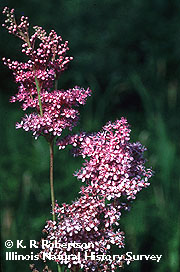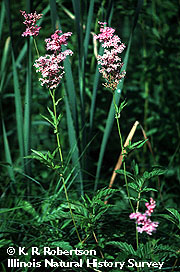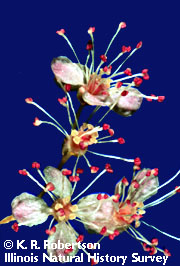Because many prairie plants are beautiful in themselves, they are often cultivated in gardens. In fact, many herbaceous perennial borders throughout the world contain numerous species native to prairies. Examples include:
Queen-of-the-prairie (Filipendula rubra)
Cone-flowers (Echinacea pallida and E. purpurea)
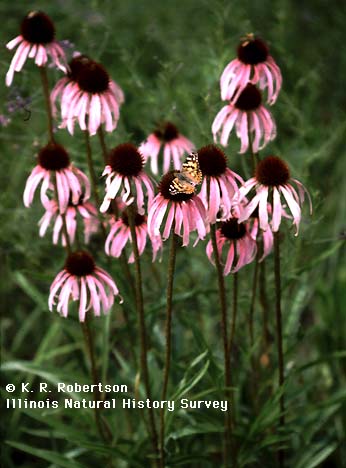
Obedient plant (Physostegia virginiana)
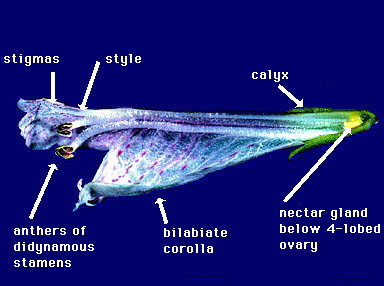
Sunflowers (Helianthus species)
Blazing stars (Liatris species)
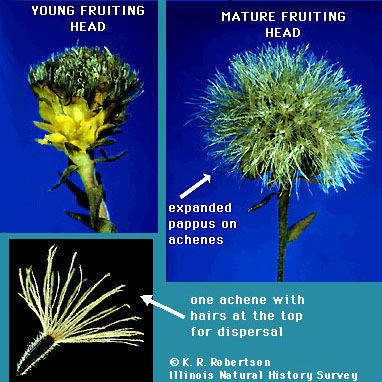
Goldenrods (Solidago species)
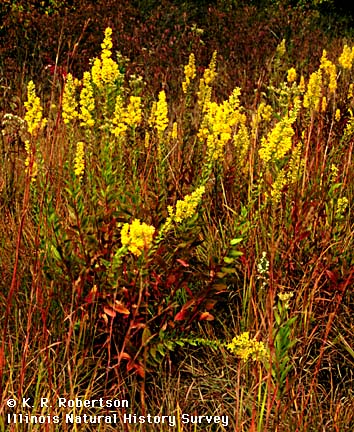
Black-eyed Susan (Rudbeckia hirta)
More information about landscaping with prairie plants
The first European settlers to arrive in Illinois encountered a fabulous natural landscape. The northern part of the state was a mosaic of many prairies types, wetlands, forests, and savannas. Along the magnificent natural shoreline of Lake Michigan were beaches, sand dunes, swales, and cliffs dissected by wooded ravines. The central part of Illinois was primarily tallgrass prairie, spectacular at all seasons, dotted with isolated woods known as prairie groves. Towards the west and south the prairies gave way to mature forests and tall cliffs of sandstone and lime-stone. Occurring at the extreme southern part of the state were swamps filled with giant bald cypress and tupelo trees, reminiscent of places much farther south and lacking only Spanish moss and alligators. What a sight this original and wild Illinois must have been!
The rapid settlement and subsequent economic development of Illinois has dramatically affected the biology of Illinois. Most of this development has been based on the conversion of original native habitat to agricultural fields and areas for industry and urban development. Logging, mining, and pollution have degraded the remaining natural habitats. Alas, only a tiny fraction of the original prairies, forests, savannas, and wetlands have survived. Today, Illinois ranks 49th among the states in the percentage of presettlement vegetation remaining today (Iowa is 50th).
Today, however, many people are concerned about how human activities are modifying the very nature of our world. Climatic changes, toxic pollution, erosion, diminishing water quality, food shortage, and depletion of our non-renewable energy resources affect everyone’s life. Native vegetation soaks up pollution, captures and store carbon dioxide, filters and dilutes noise, dust, and exhaust pollution, retards erosion and loss of top soil, and prevents siltation of our streams, rivers and lakes. Cultivated landscapes that use native species require less maintenance, such as mowing and the application of fertilizers and herbicides. Using native landscaping also helps activate local interest in environmental issues and stimulate grassroots efforts for an environmentally sound Illinois.
There are numerous books and magazine/journal articles on this subject that are available in bookstores and in libraries. Below are some links about natural landscaping and sources for native plants that you might find useful. These sites are not listed in any particular order.
*Disclaimer: The listing of companies or individuals below does not represent an endorsement of these organizations or their products by the author, the Illinois Natural History Survey, the Prairie Research Institute, nor the University of Illinois.
- McHenry County Defenders
- Lady Bird Johnson Wildflower Center, formerly the National Wildflower Research Center
- PlantNative: How to Naturescape
- Landscaping with Native Plants from the Minnesota Department of Natural Resources
- Landscaping With Native Plants, from the Tennessee Exotic Pest Plant Council
- Native Plants for Conservation, Restoration, and Landscaping from the Virginia Natural Heritage Program
- Native Plants for a California Garden, Gardening and Landscaping with Native Plants
links last updated 10 May 2011
